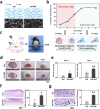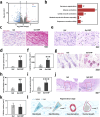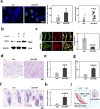SHP099-containing multi-targeting hydrogel promotes rapid skin reconstruction through modulating a variety of cells
- PMID: 40260019
- PMCID: PMC12009829
- DOI: 10.3389/fbioe.2025.1564827
SHP099-containing multi-targeting hydrogel promotes rapid skin reconstruction through modulating a variety of cells
Abstract
Introduction: Adult wound scarring result in functional skin deficits. However, the development of effective measures to modulate the entire wound healing to encourage the skin function reconstruction is still a clinical challenge, as multiple cells are involved in wound healing hierarchically. Hydrogel scaffolds with long-lasting local release provide new insights into the clinical relevance of entire wound healing.
Methods: Herein, a multi-targeting hydrogel loaded with SHP099 (Gel-SHP) is designed to modulate multiple cells during wound repair.
Results: Our results show that Gel-SHP promotes rapid reconstruction of wound skin by modulating macrophages in the inflammatory stage, fibroblasts in the regeneration stage and smooth muscle cells in the remodelling stage. Gel-SHP could increase M2 macrophage differentiation and remodel the dermal shell of hair follicles through in situ release. Moreover, Gel-SHP may modulate myofibroblasts to promote wound contraction through SHP099-scaffold synergistic interactions.
Discussion: Our results provide new insights into the design of functional hydrogels for tissue regeneration applications. Gel-SHP as a promising tool could provide new clues and new research paradigms for future studies and understanding of the wound healing process and dermal shell formation.
Keywords: SHP099; hair follicle dermal shell; macrophage; multi-targetinghydrogel; myofibroblast; wound healing.
Copyright © 2025 Liu, Chen, Hao, Hou, Lv, Zhu and Han.
Conflict of interest statement
The authors declare that the research was conducted in the absence of any commercial or financial relationships that could be construed as a potential conflict of interest. The author(s) declared that they were an editorial board member of Frontiers, at the time of submission. This had no impact on the peer review process and the final decision.
Figures





Similar articles
-
Dual-Action Icariin-Containing Thermosensitive Hydrogel for Wound Macrophage Polarization and Hair-Follicle Neogenesis.Front Bioeng Biotechnol. 2022 Jun 27;10:902894. doi: 10.3389/fbioe.2022.902894. eCollection 2022. Front Bioeng Biotechnol. 2022. PMID: 35832407 Free PMC article.
-
Regeneration of Dermis: Scarring and Cells Involved.Cells. 2019 Jun 18;8(6):607. doi: 10.3390/cells8060607. Cells. 2019. PMID: 31216669 Free PMC article. Review.
-
Dextran hydrogel scaffolds enhance angiogenic responses and promote complete skin regeneration during burn wound healing.Proc Natl Acad Sci U S A. 2011 Dec 27;108(52):20976-81. doi: 10.1073/pnas.1115973108. Epub 2011 Dec 14. Proc Natl Acad Sci U S A. 2011. PMID: 22171002 Free PMC article.
-
TGFβ functionalized starPEG-heparin hydrogels modulate human dermal fibroblast growth and differentiation.Acta Biomater. 2015 Oct;25:65-75. doi: 10.1016/j.actbio.2015.07.036. Epub 2015 Jul 26. Acta Biomater. 2015. PMID: 26219861
-
Dermal Fibroblast Heterogeneity and Its Contribution to the Skin Repair and Regeneration.Adv Wound Care (New Rochelle). 2022 Feb;11(2):87-107. doi: 10.1089/wound.2020.1287. Epub 2021 Mar 23. Adv Wound Care (New Rochelle). 2022. PMID: 33607934 Review.
References
-
- Burmeister B. T., Taglieri D. M., Wang L., Carnegie G. K. (2012). Src homology 2 domain-containing phosphatase 2 (Shp2) is a component of the A-kinase-anchoring protein (AKAP)-Lbc complex and is inhibited by protein kinase A (PKA) under pathological hypertrophic conditions in the heart. J. Biol. Chem. 287, 40535–40546. 10.1074/jbc.M112.385641 - DOI - PMC - PubMed
LinkOut - more resources
Full Text Sources

